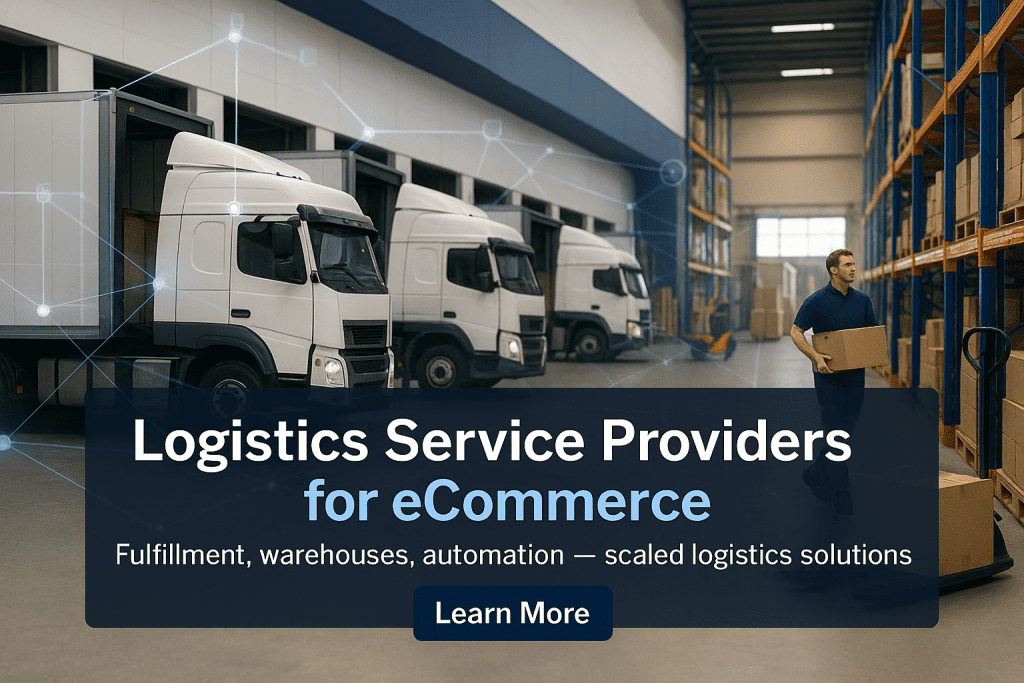Author: Jason Martin
Reviewed by: Ecommerce Operations Lead
Last updated: October 27, 2025
Executive TLDR
-
Most brands don’t need a giant network, they need one accountable partner that ships fast and protects margin.
-
Pick an ecommerce-focused 3PL fulfillment partner with barcode-first ops, clear ASNs, and a proven pack matrix.
-
Centralize inventory in the Midwest to hit 1–3 day ground while discounted shipping rates keep costs down.
-
Lock a 30-day onboarding plan: product master, ASN receiving, slotting, scan at pick and pack, and one daily cut-off.
-
Track five KPIs daily: dock-to-stock, order accuracy, on-time ship rate, billable vs actual weight, and cost per order.
Want a short list and a clean handoff — Talk to an Expert
Table of contents
-
What “logistics service provider” really means
-
The types of providers you’ll hear about
-
What ecommerce brands actually need
-
Core capabilities to demand from your partner
-
Technology and integrations that matter
-
The 30-day onboarding playbook
-
KPIs to monitor every day
-
Why Product Fulfillment Solutions
-
FAQ
What “logistics service provider” really means
It is any company that moves or stores your goods: parcel carriers, freight forwarders, fulfillment warehouses, returns specialists, and more. For ecommerce brands, the center of gravity is the fulfillment warehouse that receives inventory, stores it well, and ships orders fast and right.
The types of providers you’ll hear about
-
Carriers (parcel, regional, LTL): Move boxes and pallets. Your partner should rate shop them for you. See discounted shipping rates.
-
Freight/forwarders: Bring containers and pallets into the country and to your warehouse.
-
Fulfillment centers / 3PLs: Do receiving, storage, pick and pack services, kitting, returns, labels, and compliance.
-
Specialists: Kitting houses, subscription builders (subscription box fulfillment), or retail prep (EDI solutions and connections, FBA prep services).
Most brands benefit from consolidating under one accountable 3PL that coordinates the rest.
What ecommerce brands actually need
-
Speed without air: A central U.S. hub (Cincinnati) reaches most customers in 1–3 days by ground. See ecommerce fulfillment services.
-
Accuracy first: Scan at pick and again at pack. Clear bin IDs. Simple pack matrix.
-
Cost control: Right-size packaging plus rate shopping on every label.
-
One inventory pool: Serve DTC, marketplaces, and retail from the same stock.
-
Category fit: For supplements and cosmetics, enforce FEFO with lot/expiry tracking. See health and wellness fulfillment services.
Core capabilities to demand from your partner
1) Clean receiving (ASNs + dock discipline)
-
Advance ship notices that match carton/pallet labels.
-
Booked dock times and an exception lane.
-
A target of 1–3 day dock to stock. Explore warehousing and storage solutions for overflow.
2) Barcode-first operations
-
Scan at pick, second scan at pack, look-alikes separated, big high-contrast bin IDs.
-
Labels print only after the final scan.
3) Packaging standards that cut DIM
-
Posted mailer/box matrix by product family.
-
Damage rates and billable weight tracked daily.
4) Multi-channel readiness
-
DTC, retail, and marketplace flows from the same ruleset: B2B and retail fulfillment, FBA prep services.
5) Kitting and value-add off the main line
-
Kitting assembly services and subscription box fulfillment staged so DTC isn’t slowed.
6) Shared visibility
-
Orders, inventory, exceptions, and SLAs visible to both teams with real time information.
Technology and integrations that matter
-
Shopping carts and marketplaces: Fast, reliable ecommerce integrations.
-
Data hygiene: One product master per SKU (barcode, dimensions, weight, case/inner, hazards).
-
Simple label templates: Unit/inner/carton/pallet maps saved and shared.
-
Routing/compliance: Retail and EDI routing via EDI solutions and connections.
The 30-day onboarding playbook
Week 1 — Clean inputs
-
Build the product master.
-
Finalize ASN format; share sample labels.
-
Draft the pack matrix by product family.
Week 2 — Inbound discipline
-
Book dock schedule and staff to it.
-
Create exception lane for OS&D.
-
Start reporting dock-to-stock daily.
Week 3 — Floor & outbound
-
Slot fast movers near pack; separate look-alikes; print large bin IDs.
-
Turn on scan at pick and second scan at pack.
-
Post one daily cut-off.
Week 4 — Pilot & tune
-
Live pilot on top movers.
-
Track order accuracy, on-time ship rate, handling time, billable vs actual weight, and cost per order.
-
Fix outliers, then scale to the full catalog.
KPIs to monitor every day
-
Dock-to-stock time (goal: 1–3 days)
-
Order accuracy (goal: ≥99.7%)
-
On-time ship rate (hit the posted cut-off)
-
Billable vs actual weight (packaging + DIM control)
-
Cost per order (all-in, trend weekly)
Why Product Fulfillment Solutions
-
Central U.S. hub (Cincinnati) for 1–3 day ground to most customers.
-
Barcode-first receiving aligned to accurate ASNs for predictable dock-to-stock speed.
-
Pick & pack standards with right-size packaging and scan-at-pack.
-
Parcel optimization that rate shops every label via discounted shipping rates.
-
Category fit for consumables with FEFO/lot/expiry control.
-
Retail/marketplace readiness through EDI solutions and connections and FBA prep services.
FAQ
Do we need multiple warehouses to be fast
Start centralized. A Midwest hub reaches most buyers quickly with ground. Add nodes only when data proves savings and service gains.
How fast can we onboard with a 3PL
Plan four weeks. Clean data and labels in week one, lock ASN/dock in week two, slot and scan in week three, pilot and tune in week four.
How do we control shipping costs
Right-size packaging and rate shop every label. Blend national and regional carriers.
Can one pool serve DTC, retail, and marketplaces
Yes. Standardize data and labels once, then route by promise and cost from a single pool.
What accuracy should we target
Aim for 99.7% or better with scan at pick and a second scan at pack.

